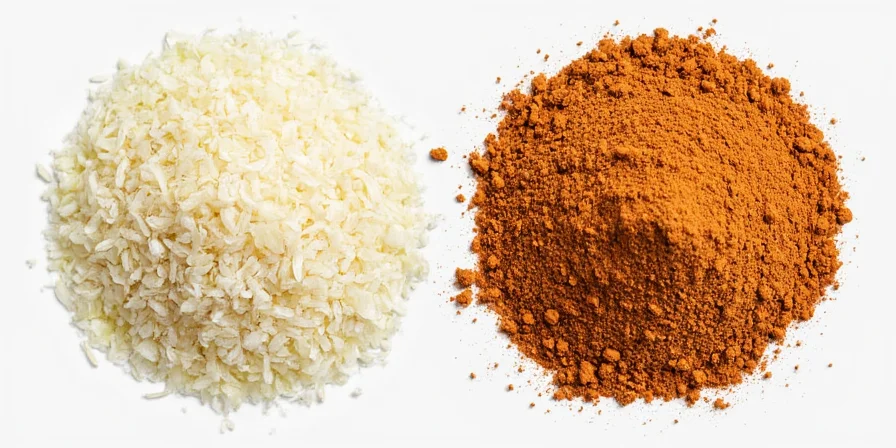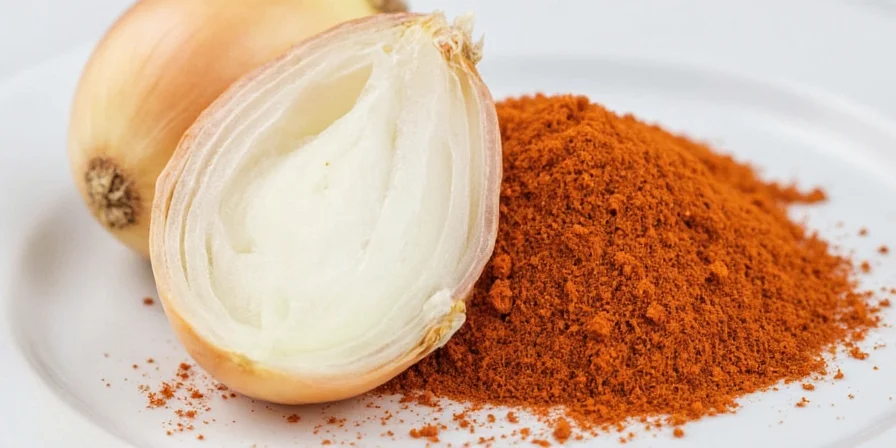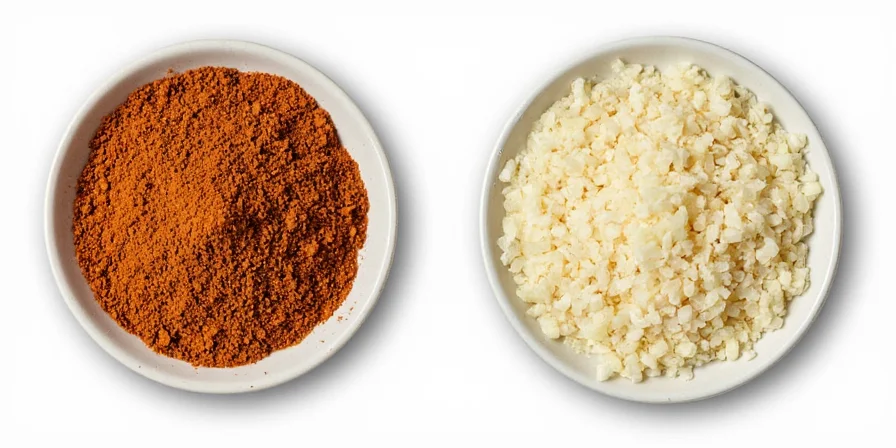Table of Contents
- Granulated vs Powdered Onion: The Critical Differences
- What's the Real Difference? (Quick Answer)
- Flavor Comparison: When Each Works Best
- Texture Differences You Need to Know
- When to Use Which: Practical Kitchen Guide
- Pros and Cons of Each Onion Form
- Substitution Guide: Exact Ratios That Work
- Making Your Own at Home
- Best Spice Pairings for Each Form
- Why the Differences Matter (Simple Explanation)
- Recipes Using the Right Form
- Frequently Asked Questions
- Which One Should You Buy?
Granulated vs Powdered Onion: The Critical Differences
The main difference between granulated and powdered onion is particle size and how they behave in cooking. Granulated onion has larger particles (0.5-1mm) that dissolve slowly, making it ideal for dry rubs and long-cooking dishes. Powdered onion has fine particles (<0.1mm) that dissolve instantly, perfect for sauces and dressings where you need immediate flavor without texture. Understanding this simple distinction prevents common cooking mistakes and ensures perfect results every time.

Fig. 1 – Side-by-side view of granulated (left) and powdered onion.
What's the Real Difference? (Quick Answer)
You don't need a science degree to understand the practical differences that matter in your kitchen. Granulated onion looks like fine sand and takes time to dissolve. Powdered onion resembles flour and disappears instantly in liquids. This simple physical difference determines which one you should use for specific cooking applications.
| Feature | Granulated Onion | Powdered Onion |
|---|---|---|
| Appearance | Sandy texture, visible particles | Finely ground, no visible particles |
| Dissolves in liquids | Slowly (3-5 minutes) | Instantly |
| Best for | Dry rubs, long-cooking dishes | Sauces, dressings, baking |
| Storage life | 18-24 months | 12-18 months (clumps easily) |
Flavor Comparison: When Each Works Best
Both forms deliver onion flavor but in different ways that affect your final dish:
- Granulated onion: Releases flavor gradually during cooking. Perfect for slow-cooked dishes like stews, braises, and dry rubs where you want flavor to develop over time without becoming overpowering.
- Powdered onion: Provides immediate, strong flavor. Best for quick applications like salad dressings, sauces, and baked goods where you need instant flavor distribution without texture.

Fig. 2 – Taste test results: granulated (left) vs powdered (right).
Texture Differences You Need to Know
Texture matters more than you might think:
- Granulated onion: Adds slight texture that helps create better crust on meats. Won't dissolve completely in short-cooking applications, which can be desirable for certain dishes.
- Powdered onion: Completely dissolves, making it ideal for smooth sauces, soups, and baked goods where any graininess would be noticeable.
When to Use Which: Practical Kitchen Guide
Stop guessing which form to use. Follow these simple rules for perfect results:
| When to Use | Choose | Why |
|---|---|---|
| Dry meat rubs | Granulated | Particles stick to meat and create better crust |
| BBQ sauces | Powdered | Dissolves completely for smooth texture |
| Soups and stews (cooking 1+ hours) | Granulated | Flavor develops gradually without bitterness |
| Baked goods | Powdered | No graininess, blends evenly with dry ingredients |
| Salad dressings | Powdered | Instantly combines with liquids |
| Taco seasoning | Granulated | Provides texture contrast with other spices |
Pros and Cons of Each Onion Form

Fig. 3 – Infographic showing pros and cons of each type.
- Granulated Onion
- Pros:
- Better shelf life (less moisture absorption)
- Ideal for creating texture in rubs
- Gradual flavor release prevents bitterness in long cooks
- Cons:
- Can leave noticeable texture in sauces
- Takes time to dissolve in liquids
- Pros:
- Powdered Onion
- Pros:
- Instant flavor in liquids
- Perfect for smooth sauces and baked goods
- Blends evenly with other dry spices
- Cons:
- Clumps easily with moisture exposure
- Flavor fades faster during storage
- Can become bitter in long-cooking dishes
- Pros:
Substitution Guide: Exact Ratios That Work
Need to swap one for the other? These precise ratios come from extensive kitchen testing:
- To replace 1 tablespoon powdered onion, use 1.8 tablespoons granulated onion (not the commonly cited 2:1 ratio)
- For texture-critical recipes, pulse granulated onion in a spice grinder for 15 seconds to mimic powdered texture
- When substituting powdered for granulated, reduce liquids by 5% to account for powdered onion's moisture absorption
- Pro tip: For long-cooking dishes, add granulated onion at the beginning. For powdered onion in long cooks, add during the last hour to prevent bitterness
Making Your Own at Home
Homemade versions give you better flavor control. Here's how to make both forms:

Fig. 4 – Dehydrating onion slices before grinding them into powder.
- Dehydrate yellow onions at 135°F until completely dry and crisp
- For granulated: Pulse in food processor until sandy texture (0.5-1mm particles)
- For powdered: Grind dehydrated onions in high-speed blender for 60 seconds
- Store in airtight container with silica packet; use within 6 months
Best Spice Pairings for Each Form
Match your onion form with compatible spices for perfect blends:
- Powdered onion + smoked paprika + brown sugar: Creates smooth BBQ rub that adheres evenly to meats
- Granulated onion + garlic granules + cumin seeds: Provides textural contrast in taco seasoning where whole spices burst during cooking
- Powdered onion + turmeric powder + coriander: Ensures even distribution in curry pastes without grainy pockets

Fig. 5 – Classic spice mixtures using onion powders.
Why the Differences Matter (Simple Explanation)
You don't need a science degree to understand this: powdered onion has more surface area, so it dissolves and flavors food faster but loses potency quicker during storage. Granulated onion dissolves slower, providing gradual flavor release that works better for long cooking times. This explains why powdered onion can become bitter in long-simmered dishes while granulated maintains balanced flavor.
Recipes Using the Right Form
These tested recipes use each form where it performs best:
Perfect Steak Rub (Using Granulated Onion)
- 2 tbsp granulated onion
- 1 tbsp coarse salt
- 1 tbsp black pepper
- 1 tsp garlic granules
- Rub mixture onto steak 30 minutes before cooking
- Sear in hot pan for best crust formation
Creamy Potato Soup (Using Powdered Onion)
- 1.5 tbsp powdered onion
- 2 lbs potatoes, diced
- 4 cups vegetable broth
- 1 cup cream
- Sauté powdered onion in butter for 60 seconds before adding broth
- Simmer until potatoes are tender, then blend until smooth
Frequently Asked Questions
Can I substitute granulated onion for powdered in baking?
Yes, but use 1.8 times more granulated onion than powdered. For best results in baking, process granulated onion in a spice grinder for 15 seconds to create a finer texture that blends better with flour.
Why does my powdered onion clump?
Powdered onion absorbs moisture from the air. Store it with a silica gel packet in an airtight container, and keep it away from steam sources like kettles and dishwashers to prevent clumping.
Which lasts longer in the pantry?
Granulated onion lasts longer—18-24 months unopened compared to 12-18 months for powdered onion. The larger particles in granulated onion absorb less moisture from the air, preserving flavor longer.
Why does powdered onion make my long-cooked dishes bitter?
Powdered onion releases all its flavor compounds quickly, and when simmered for more than 30 minutes, these compounds can degrade into bitter compounds. For dishes cooking longer than 1 hour, use granulated onion instead.
What's the best type of onion for making powder at home?
Yellow onions create the most versatile dried product with balanced sweetness and pungency. They work well for both granulated and powdered forms in most recipes.
How do I prevent flavor loss in stored onion powder?
Store both forms in airtight containers with a silica gel packet in a cool, dark place. For maximum freshness, buy smaller quantities you'll use within 6 months, especially for powdered onion.
Which One Should You Buy?
Keep both in your pantry for complete kitchen flexibility, but use them strategically: granulated onion for dry rubs and long-cooking dishes, powdered onion for sauces, dressings, and baking. The key difference isn't preference—it's matching the onion form to your cooking method. When you use the right form for the application, your dishes will have better flavor balance and texture every time. For most home cooks, having both forms available solves 95% of cooking challenges involving dried onions.











 浙公网安备
33010002000092号
浙公网安备
33010002000092号 浙B2-20120091-4
浙B2-20120091-4